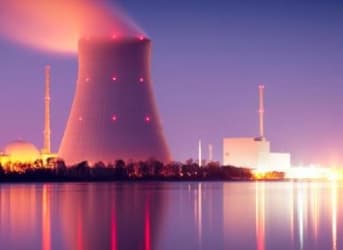The cost of building large, conventional nuclear power plants continues to escalate, leading the nuclear industry to explore an alternative, the small modular reactor (SMR). These plants, less than 300 megawatts in size, are "small" only when compared to a conventional nuclear reactor or full size (1000 MW) fossil fuel plant. The nuclear industry hopes that factory built SMRs will eliminate construction delays and quality control issues that have plagued nuclear projects such as EDF's Flamanville and Olkiluoto. Small reactor designs include advanced light water reactors (LWRs), high temperature gas cooled (helium) and molten metal cooled (sodium) systems. LWRs that use regular water for cooling and steam are the more conventional technology. At the US Department of Energy, a LWR design from NuScale Power is currently proceeding along the regulatory path outlined in the agency's SMR Licensing and Technical Support program. A second design group which offered a scaled down version of Westinghouse's AP1000 design, appears to have downgraded its efforts.
The NuScale Power offers a pressurized water reactor with passive safety features. Passive meaning that the facility can shut down and self cool with no operator action. And this ability to shut down does not depend on access to on-site or off site power. The reactor harnesses three natural processes gravity, convection and conduction for normal operation and safe shutdown.
The NuScale Power Module is a self-contained unit capable of generating about 50 megawatts of electricity. It houses the reactor, steam generator and pressurizer in a single unit installed below ground, allowing for a smaller, less expensive containment structure. The module uses natural circulation of heated and cooled water to eliminate the need for piping and reactor coolant pumps that remove excess heat in a conventional reactor. It is also relatively compact standing 65 feet by 9 feet at its base. Related:$120 Oil As Soon As 2018?
The U.S. DOE has set two key milestones for development. In late 2016, the company expects to submit its Design Certification application to the U.S. Nuclear Regulatory Commission (NRC). By mid-2019 the company hopes to complete the final design. A potential TVA site at Clinch River, which already houses nuclear facilities, has been discussed. NuScale is planning a 500+ MW project, with an estimated cost of $3 billion. Several power agencies in the western U.S. are also involved in this effort. The project might receive a Construction and Operating License (COLA) from the NRC in the early 2020s. As a cautionary note, the U.S. DOE's website states that "demonstrating the viability of SMRs will require overcoming many technical, regulatory, financial and institutional challenges". A potential commercial operation date of 2025 is mentioned.
NuScale estimates that its 50 mw nuclear module will have an installed cost of $5,100 per kilowatt — not cheap compared to a new combined cycle natural gas fueled power station at $900 per KW installed. The World Nuclear Association citing an OECD study, "The Projected Costs of Generating Electricity", estimates that SMRs and other so called fourth generation reactor designs might cost 50-100 percent more than current third generation reactors in operation. The report includes the hopeful observation that "SMRs are expected at best to be on a par with large nuclear if all of the competitive advantages...are realized." Related: Oil Speculators Run Out Of Reasons To Bet On Rising Prices
If not cost, what advantages do SMRs offer? Perhaps most important, the entire nuclear module will be fabricated in a factory and then shipped via conventional means as one unit by truck, rail or barge, which might dramatically shorten construction times and reduce project risk. NuScale claims a 28 month construction schedule from first concrete pour to mechanical completion. In addition the relatively small size of the modules affords greater siting flexibility which would facilitate locating reactor modules in existing "brownfield" sites. Refueling is expected to occur every 24 months.
Passive safety features add to the SMR’s appeal. Its zero carbon 'footprint" contributes to long term climate goals too. Pro nuclear environmentalists occupy a peculiar and precarious niche in the political ecosystem especially in Europe. The relentless cost escalation and other difficulties related to Hinkley C in the UK are not helping their cause. A successful SMR would. Related:Why Oil Prices Will Rise And Many Pundits Will Be Caught By Surprise
The World Nuclear Association, made two cautionary observations about the SMR in its updated March 2016 report. First, competitive electric power markets presently faced "challenges" in providing incentives for capital intensive investment. Second, in the nuclear power industry both costs and delivery challenges tend to be underestimated. Both observations are couched in understatement.
Small modular reactors are neither a panacea nor likely to herald a nuclear power resurgence. They could solve one problem for the industry, lengthy construction cycles, but only at a high cost. And SMRs will need to compete in an increasingly commoditized electricity market . In a commodity industry, with no product differentiation, there is one winning strategy: charge low prices.
These small reactors are being proposed at a time when distributed and renewable electrical systems are becoming more economical. The very notion of dropping a technologically complex, pricey, base load power plant (nuclear or otherwise) into a no-growth environment for the electric utility industry is problematic at best. This all suggests that SMRs, if commercialized, will have a limited market unless they come into service at sharply lower prices. They do not yet look like next "big" thing.
ADVERTISEMENT
By William Tilles and Leonard Hyman for Oilprice.com
More Top Reads From Oilprice.com:
- Shocking Photo: Nearly 30 Oil Tankers in Traffic Jam Off Iraqi Coast
- Crude Rally Pauses After Strong Gains
- Are The Saudis And Russians Deliberately Sabotaging Doha?



















Your article does not mention nuclear waste. How will the nuclear waste produced in small modular reactors be stored or disposed of?